This one is paraded on the right of all the battalions and companies, is believed to pre-date the modern Army (1762), and is considered the main flag of the whole army.
Colours of Shree Devidutta Battalion
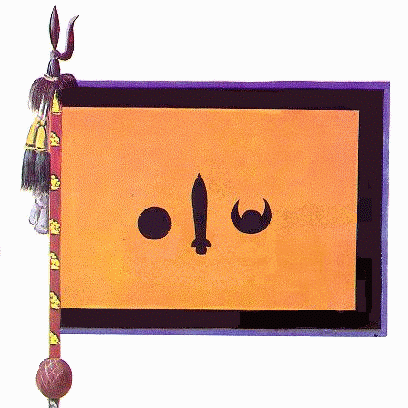 by Todd Mills, 21 June 1997
by Todd Mills, 21 June 1997
Last modified: 2014-03-08 by ian macdonald
Keywords: nepal | gorkha |
Links: FOTW homepage |
search |
disclaimer and copyright |
write us |
mirrors
The modern Nepalese Army was founded in 1762, and today consists of 22 battalions and 44 independent companies.
At least one of these is cavalry, and a few others have since WWII converted to artillery, engineers and signals without
any change in their old names or in their colours. The Nepalese gave the British Army quite a licking in an 1814-16 border
war, and have been perpetual friends and allies of Britain and India ever since. Nepal supplied the British Indian Army with
ten regiments of Gurkha mercenaries. At Indian independence six remained in India, and four went directly to the British Army.
By British tradition these are "Rifle" regiments and do not carry colours. The Nepalese Army on the other hand has always been
sovereign, and shows not a trace of British influence. Nepalese units have been rotating on UN peacekeeping duty in Lebanon
since 1978, but I don't know if they have taken their Colours with them.
Todd Mills, 21 June 1997
At
the official site of the Royal Nepalese Army, is what would seem to be the
Royal Nepalese Army flag: red, about 1:2, with a black swords-wreath-crown-moon
device (as seen on the Nepalese flag) in the fly and the
Nepalese national flag on a red bordered white rectangle in upper hoist.
Joe McMillan, 28 January 2003
In the device, the wreath is on the
bottom, and it is probably a swords/wings*/torch device in the center.
Nathan Lamm, 28 January 2003
*These are not wings, but two crossed
"kukris" -- Gurkha knives. A photograph of one can be found
here.
Santiago Dotor, 29 January 2003Police or Army Flag
From Flaggenmittelungen 1795(?), translated by Jarig Bakker:
Nepal: On a postage stamp a police- or army- flag has been depicted: on blue with a red border two crossed golden swords, on top of which a laurel wreath. On top of the center piece the royal crown with tail (?), all in white; below the center piece a white banderole with red inscription (text not readable)Jaume Ollé, 09 Oct 1999
The sample colours are adapted (scanned and considerably retouched) from watercolours in "Royal Nepalese Army Colours: a Short
History" by an Army History Task Force (1991). The book gives a brief history of each battalion and company, but virtually no
information on the significance of the colours. They seem to follow no rules, and vary wildly in size, shape, and colours. In fact,
these variations seem to be the distinctions between units. (Two units have flags in the same shape as the national flag.) Most of
the Army units date from the late 18th and early 19th century, and their flags do not appear to have been altered in any way since then.
The devices on the national flag occur frequently on Army colours. Other common devices are a dagger, and a pair of footprints.
Todd Mills, 21 June 1997
According to Smith (1975b), the footprints of Buddha point
to Buddha's birthplace in what is now Nepal.
Ole Andersen, 13 October 1999
All 46 flags and colours of the Royal Nepalese Army can be seen on the
RNA website.
Gerald Noeske, 1 July 2005
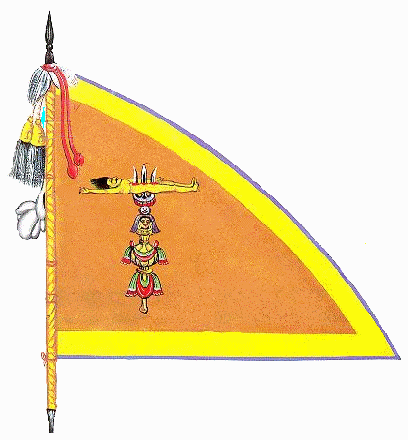 by Todd Mills, 21 June 1997
by Todd Mills, 21 June 1997 [Click on flag for larger image.]
This one is paraded on the right of all the battalions
and companies, is believed to pre-date the modern Army (1762), and is considered the main flag of the whole army.
Colours of Shree Devidutta Battalion
 by Todd Mills, 21 June 1997
by Todd Mills, 21 June 1997
[Click on flag for larger image.]
Awarded by the King in 1785 for gallantry in battle.
These Colours are considered "divinely consecrated" and every officer in the Army takes his oath while touching these Colours. The
Colours are also considered the protector of the Capital and never leave Kathmandu.
Colours of Shree Bhairavnath Battalion
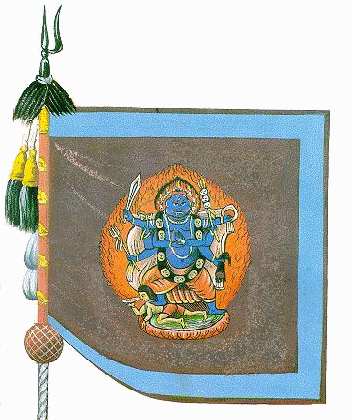 by Todd Mills, 21 June 1997
by Todd Mills, 21 June 1997
[Click on flag for larger image.]
Raised in 1810, and now a parachute battalion.
Colours of Shree Ganeshdal Battalion
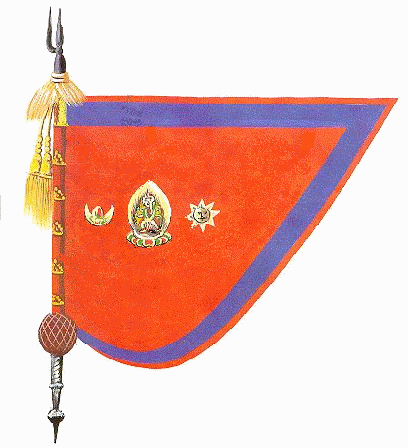 by Todd Mills, 21 June 1997
by Todd Mills, 21 June 1997
[Click on flag for larger image.]
Raised in 1846, and now responsible for all the
signals and communications of the Army.
Colours of Shree King's Household Cavalry
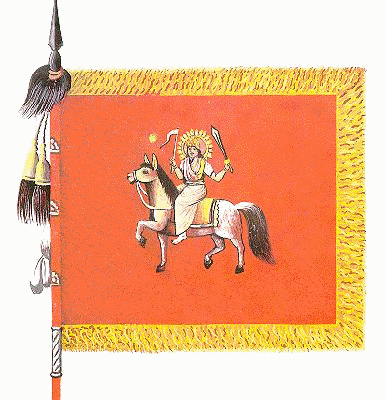 by Todd Mills, 21 June 1997
by Todd Mills, 21 June 1997
[Click on flag for larger image.]
Raised in 1849, and has acted as Household Cavalry
ceremonial unit since 1952.
Colours of Shree Vajradal Company
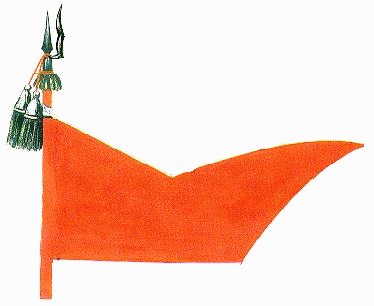 by Todd Mills, 21 June 1997
by Todd Mills, 21 June 1997
[Click on flag for larger image.]
Raised 1806.
Colours of Shree Bhagvati Prasad Company
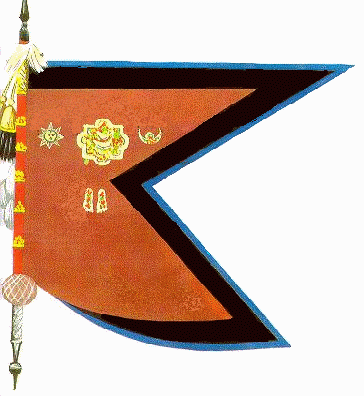 by Todd Mills, 21 June 1997
by Todd Mills, 21 June 1997
[Click on flag for larger image.]
Raised in 1927.
Colours of Shree Parshwavarti Company
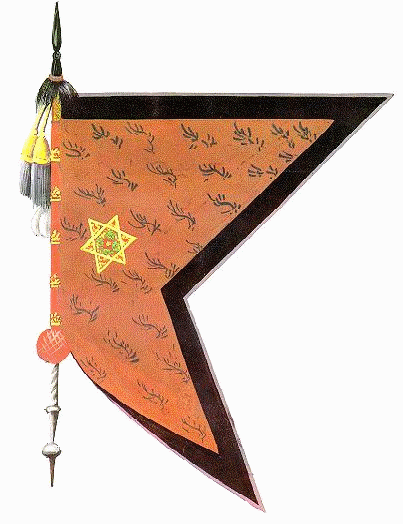 by Todd Mills, 21 June 1997
by Todd Mills, 21 June 1997
[Click on flag for larger image.]
Raised 1936 and disbanded 1952. Was the Prime Minister's bodyguard.
![[Gurkha Soldiers Organization]](../images/n/np_gsorg.gif) image
by Roman Kogovsek and Jaume Olle
image
by Roman Kogovsek and Jaume Olle
Gorkhas are professional soldiers, who have been and still are serving in
Nepalese and foreign armies (India, Great Britain, Brunei). This organization
mainly advocates for their social rights.
Roman Kogovsek, 30 June 2005
The Gurkha Army Ex-Servicemen Organisation (GAESO) uses an olive green flag
with crossed kukris;
sometimes the letters GAESO in white are added below the kukris. Several photos
can be found on the web or at the GAESO web page,
http://gaeso.org.np/gaeso/.
(one photo at http://gaeso.org.np/gaeso/wp-content/themes/goodnews/framework/scripts/timthumb.php?src=http://gaeso.org.np/gaeso/wp-content/uploads/2013/02/DSC01296.jpg&h=340&w=615&zc=1)
Perhaps is a Nepalese organization with no presence in the web, but perhaps
is the same organization: the color can be a confusion due the infrequent
shade (in some photos we can see a more normal green, and surely because the
flag was constructed from another image smaller), the differences in the kukris
must be for the scarcely clarity and size in the original, and missing name
must be because there are also flags with no letters.
I attach the
recolored flag and, at side, the photo (without inscription) of the same
flag, for the event that anyone want redraw it.
Jaume Olle, 7 December 2013
I have visited the Army Museum in Kathmandu on 15 July 2013. I have
discovered many flags and specially 132 miniatures flags (probably former Royal
Nepal Army flags , the letter "R" for Royal has disappeared) There are 132 flags
unidentified. I do not know if anybody can help for identification. I have sent
a mail to Kathmandu but no answer!
Images are presented in
this photograph.
Michel Lupant, 8 February 2014
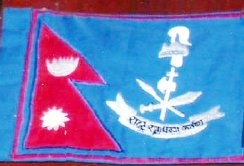 |
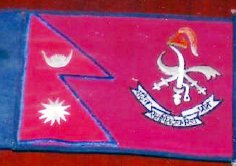 |
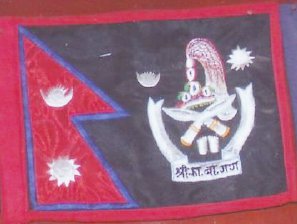 |
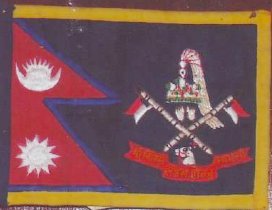 |
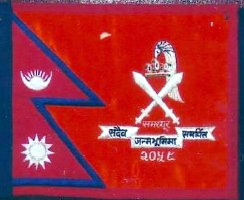 |
| 1 | 2 | 30 | 70 | 112 |
The use of the plumed helmet / crown in numbers 1, 2, 30, 70 and 112 might
indicate they belong to a Guards unit. See the flags for sale here (for the
Chief of Bodyguards)
https://www.militaria-agent.com/catalog/NEPAL_CAR_PENNON_FOR_THE_CHIEF_OF_THE_BODYGUARDS.html;
and one for the Royal Castle Guard at
https://www.militaria-agent.com/catalog/NEPAL_CAR_STANDARD_FOR_THE_ROYAL_CASTLE_GUARD_SIZE_19_X_23_5_CM.html.
Flag 70 would appear to belong to an armoured or cavalry unit.
Ian Sumner,
16 February 2014
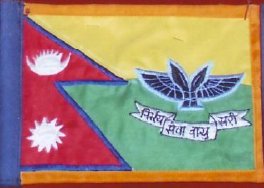 |
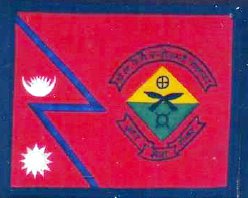 |
| 15 | 69 |
Number 15 may be that of 11 Brigade. A patch with the same badge on a
similarly coloured, diamond-shaped, badge is shown here:
http://goefoundation.org/index.php/eagles/biographies/c/chhetri-madan-khatri-k.c.
but it incidental to the article, and it is not clear whether that is the patch
for 11 Brigade as a whole, or only of its helicopter-flying element. So Number
69 may be another brigade, or another helicopter unit.
Ian Sumner,
16 February 2014
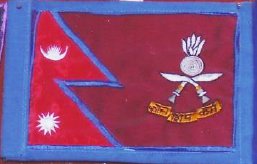 |
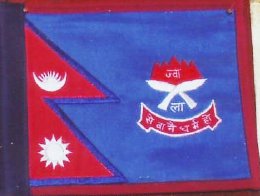 |
| 47 | 53 |
The badge on 47 is very close in appearance to that used by the Gurkha
Engineers of the British Army, so might be an engineer unit.
Number 53
might be the Shree Barakh Company - the device on the Company's colour are
similar to those shown here, although the colour is red with a green border,
whereas this one appears blue on my monitor.
Ian Sumner,
16 February 2014
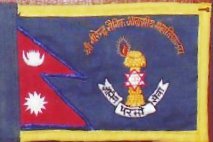 |
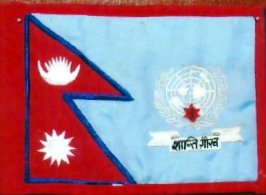 |
| 73 | 76 |
Number 73 is an educational establishment. The badge is on the Army's
Facebook page,
https://www.facebook.com/photo.php?fbid=602901563069442&set=pb.555281497831449.-2207520000.1392045284.&type=3&theater,
where it is captioned 'Sainik Awasiya Mahavidyalaya, Sallaghari, Bhaktapur
previously named as Birendra Sainik Awasiya Mahavidyalaya and Suping Campus, was
established with the joint investment of the Nepali Army (then Royal Nepalese
Army) and the Tribhuvan University (TU) at Bhimphedi of Makawanpur district on
the 14th Poush 2035.'
Number 76 is probably a unit serving with a UN
peace-keeping force. The Shree Bajra Dal Battalion (20th Batt) is just about to
go to the Congo (http://www.nepalarmy.mil.np/covernews1.php?); there is currently another
battalion there as well as an engineers detachment and an explosive ordnance
disposal is on its way to Mali.
Ian Sumner,
16 February 2014
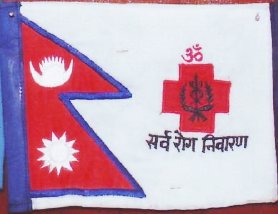 |
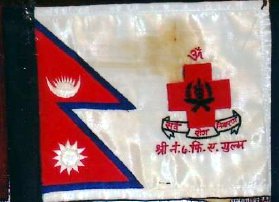 |
| 82 | 94 |
Number 82 and 94 may be medical units. Medical personnel appear to use the
rod of Aescapulus (https://www.militaria-agent.com/catalog/NEPAL_ARMY_MEDIC_ARM_BADGE.html)
although the arm patch has no Red Cross.
Ian Sumner,
16 February 2014
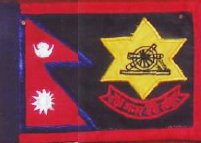 |
|
| 129 |
Number 129 is an artillery unit - the device of a gun is similar to that used
by both the British Royal Artillery and the Indian and Pakistan Artilleries.
Ian Sumner,
16 February 2014